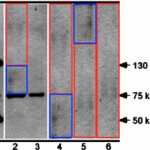A natural disaster is to blame for a retraction about lethal brain tumors. At least, that’s where the authors say the problem started: with a 2010 earthquake that caused a loss of “substantial data.”
The paper, “Superoxide-dependent uptake of vitamin C in human glioma cells,” looks at how the cells of lethal brain tumors interact with the vitamin commonly used to reduce side effects of therapies.
Post earthquake, someone digitally filled in a western blot analysis of proteins from a cell line and rat brains, as a “temporary solution.” And then the temporary solution made its way into the Journal of Neurochemistry.
Here’s the retraction note from the journal, including an image of the sneaky western blot:
A lane of a western blot image in the above referenced paper has been duplicated as control lanes. Control lanes 4, 5 and 6 of Fig. 2(b) have been reused from the top part of lane 2. The authors have explained that after losing substantial data after an earthquake in 2010, a series of digital representations were created as a temporary solution and inserted as place holders to determine which experiments needed to be repeated. However, the placeholders for control lanes 4, 5 and 6 for Fig. 2(b) were still present at the time of submission.
A commenter on PubPeer raised concerns about figure 2b last year.
We are not sure exactly how the data were lost during the earthquake. In February, 2010, Chile was hit with an 8.8 magnitude earthquake that killed hundreds of people.
To obtain more information, we contacted the corresponding author Francisco Nualart, Departamento de Biología Celular, Facultad de Ciencias Biológicas in Chile. We also asked Journal of Neurochemistry editor Jörg B. Schulz for further comment, too. We will update if either gets back to us.
Hat tip: Rolf Degen
Like Retraction Watch? Consider supporting our growth. You can also follow us on Twitter, like us on Facebook, add us to your RSS reader, and sign up on our homepage for an email every time there’s a new post.


The earth ate my results
Some buildings of the UdeC (Universidad de Concepción, Chile) were severely damaged during the 2010 earthquake, in particular with disastrous fires. Take a look at the following link, related to the Chemistry dept., located on the same campus:
http://www2.udec.cl/cienciasquimicas/index.php?option=com_content&view=article&id=61&Itemid=98
In Japan, back in March of 2011, our outsourced printer in the Tokyo area was hit bad by the earthquake related to the tsunami, affecting our publishing operations really badly. That printer went out of business as a result. So, it seems quite real, also based on what Sylvain states, quite reasonable, that data could be lost. Input from the authors would be helpful, though, because loss of data is one thing, and manipulated figures is another.
If the data was stored on a local hard drive/server that was damaged by physical trauma, fire, or water from broken pipes, it could easily have been lost. Even backups may have been lost if not offsite. I lost all of my thesis data from the Northridge quake, as the data files were too large for floppy disks or email and only resided on my office hard drive, which was irreparably damaged.
I think we should separate the issues here: it is very possible and tragic that a natural disaster can wipe out data (I have known several cases, and it doesn’t take an 8.8 magnitude earthquake, a flood/fire can easily do that). But figures that are so manipulated, even for so-called place-holders (one can easily just put an empty box with description), should not be allowed at all in any circumstances.
It is one thing to create a temporary placeholder figure using powerpoint shapes or maybe even do some crude copy and paste until the experiment is repeated. It is an entirely different thing to put in the extra work to neatly copy and paste bands, and re-align and re-size them in a way that it is not clearly visible anymore that this is not the actual data.
The stretching (lanes 4, 5, 6, by different amounts) and flipping (lane 5 only) of the lane 2 upper portion does not jibe with a claim of a “temporary solution”. One honest temporary solution would have been to clearly label those lanes as “Temporary” and leave them blank. The earthquake and its resultant damage are unfortunate and I hope all concerned have recovered well, but blaming an earthquake for all of this stretching and flipping is hardly credible. Retraction was indeed appropriate here. Kudos to the sharp-eyed reader who commented on PubPeer.